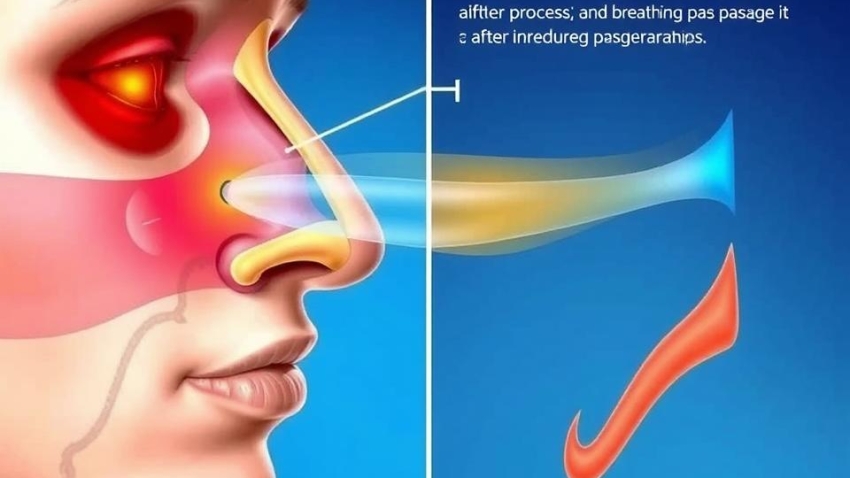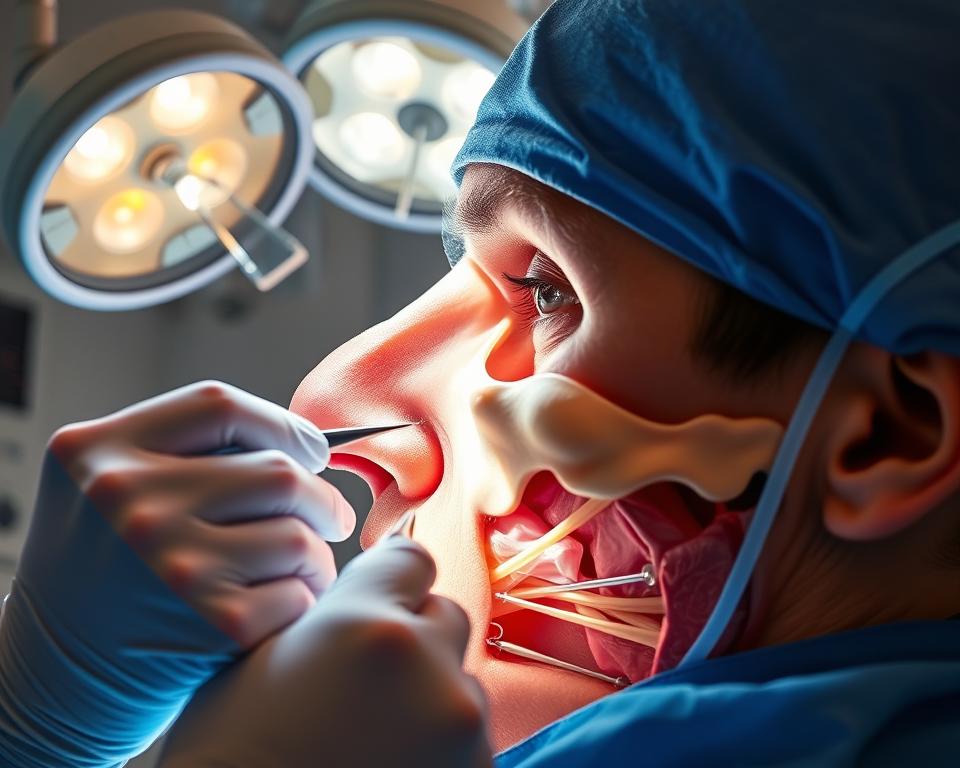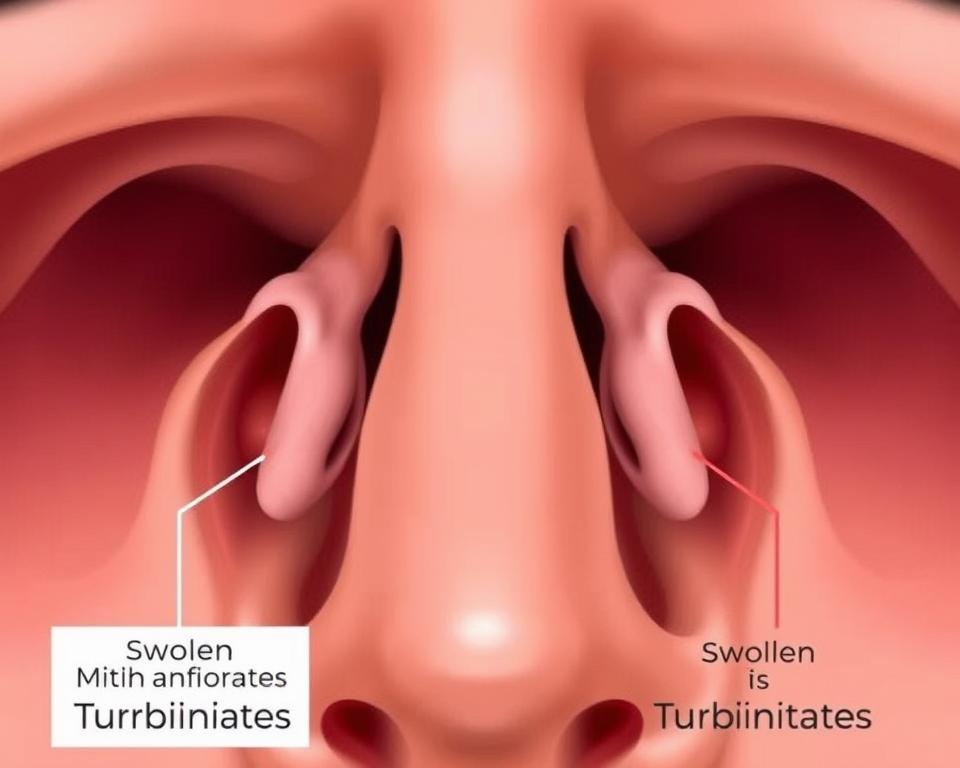
Turbinate Reduction: Nasal Breathing Improvement
Many people have trouble breathing through their nose because of chronic nasal blockage. Turbinate reduction surgery can help by making breathing easier. This surgery is a key solution for those who often feel their nose is stuffy.
We will look into why some people have enlarged turbinates and how surgery can help. We’ll also cover the benefits, types of surgery, recovery, and how it can help with other issues like a crooked septum, sinusitis, and allergies.
Read interesting things at : revolutionbookscamb
Key Takeaways
- Turbinate reduction is a surgery that makes breathing through the nose easier by shrinking the turbinates inside the nose.
- Big turbinates can cause ongoing nasal stuffiness and make breathing hard. This can also lead to other breathing problems.
- This surgery can ease these symptoms, making breathing easier and reducing nasal congestion.
- There are different ways to do this surgery, like coblation or radiofrequency ablation. It’s often done with other sinus surgeries.
- After the surgery, recovery is quick. People usually feel less nasal congestion and breathe better in a few weeks.
What is Turbinate Reduction?
Turbinate reduction is a surgery to fix turbinate hypertrophy. This means the nasal turbinates, small bones inside the nose, grow too big. This can cause nasal blockage, constant stuffiness, and other breathing problems.
Understanding Turbinate Hypertrophy
The nasal turbinates warm, humidify, and filter the air we breathe. If they get too big, often from chronic inflammation or other health issues, they block the airflow. This is called turbinate hypertrophy.
Symptoms of Enlarged Turbinates
- Persistent nasal congestion and difficulty breathing through the nose
- Chronic sinus infections or chronic rhinitis
- Frequent headaches or facial pain
- Snoring or sleep apnea
- Decreased sense of smell or taste
If not treated, enlarged turbinates can really affect someone’s life. They can lead to serious health issues. Turbinate reduction surgery helps fix these problems and improve breathing.
“Turbinate reduction is a common and effective treatment for addressing chronic nasal obstruction caused by enlarged turbinates.”
Causes of Turbinate Hypertrophy
Turbinate hypertrophy is when the nasal turbinates swell or get bigger. It has many causes. Knowing what causes it helps in treating it.
Environmental allergies are a big reason for this condition. When you’re exposed to things like pollen or dust, your nasal turbinates can get inflamed. This leads to nasal obstruction and makes breathing hard.
- Chronic sinus inflammation, from things like chronic rhinitis or allergic rhinitis, can also make the turbinates swell.
- Structural issues in the nose, like a crooked septum or nasal polyps, can mess up airflow. This can make the turbinates grow bigger as a way to compensate.
- Using decongestants for too long can cause a rebound effect. This makes the turbinates swell up even more.
Finding out why the turbinates are swollen is key to treating it. Working with a healthcare professional is a good idea. They can help make a plan that fits your needs.
| Cause | Description |
|---|---|
| Environmental Allergies | Being around allergens like pollen or dust can make the nasal turbinates swell and get inflamed. |
| Chronic Sinus Inflammation | Conditions like chronic rhinitis or allergic rhinitis can make the turbinates swell and block the nose. |
| Structural Abnormalities | Things like a crooked septum or nasal polyps can mess up airflow and make the turbinates grow bigger. |
| Decongestant Use | Using decongestants for too long can cause the turbinates to swell up even more. |
“Understanding and addressing the underlying causes of turbinate hypertrophy is key to effectively managing this condition and improving nasal breathing.”
Benefits of Turbinate Reduction
Turbinate reduction surgery offers big benefits. It helps with better nasal airflow and eases chronic nasal congestion.
Improved Nasal Airflow
One key advantage is better nasal breathing. By shrinking the turbinates, the nasal passages get bigger. This lets more air flow through the nose.
This makes breathing easier, both during the day and at night.
Relief from Chronic Nasal Congestion
Big turbinates often cause ongoing nasal congestion. This can really lower a person’s quality of life. The surgery reduces swelling and inflammation in the turbinates.
“Turbinate reduction has been a life-changing procedure for me. I can finally breathe freely through my nose, and the chronic congestion that I’ve struggled with for years is gone.”
This surgery tackles the main cause of nasal blockage. It greatly improves a patient’s life, making breathing easier and enhancing lung function.
Types of Turbinate Reduction Procedures
Patients have several options for improving nasal breathing and treating turbinate hypertrophy. Coblation and radiofrequency ablation are two common procedures.
Coblation Turbinate Reduction
Coblation is a minimally invasive method. It uses radio frequency energy to remove excess nasal turbinate tissue gently. A special wand is inserted into the nasal cavity to target and shrink the enlarged turbinates.
This process “melts” away the unwanted tissue without harming the healthy parts nearby.
Radiofrequency Ablation
Radiofrequency ablation is another way to reduce turbinate size. It uses controlled radio frequency energy to heat and shrink the tissue. The procedure is done under local anesthesia.
A thin probe is inserted into the nasal cavity to deliver the radiofrequency waves. This method aims to reduce bleeding and discomfort after surgery.
| Procedure | Technique | Key Benefit |
|---|---|---|
| Coblation Turbinate Reduction | Uses radio frequency energy to gently remove excess turbinate tissue | Minimally invasive with low risk of collateral damage |
| Radiofrequency Ablation | Utilizes controlled radio frequency energy to shrink turbinate tissue | Performed under local anesthesia with reduced bleeding and discomfort |
Coblation and radiofrequency ablation are effective for reducing turbinate size. They help relieve nasal obstruction and improve airflow. The choice depends on the patient’s needs and the surgeon’s skills.
Turbinate Reduction Surgery Preparation
Getting ready for turbinate reduction surgery is key to a good outcome. Patients need to go through pre-operative checks and make lifestyle changes for better recovery. Let’s look at the main steps in preparing for this surgery.
Medical Evaluation
Before the surgery, patients will have a detailed medical check-up. This includes:
- Physical examination to check the nasal structure and look for any issues
- Review of medical history, including past nasal or sinus surgeries
- Laboratory tests, like blood work or allergy tests, to find potential risks
- Imaging studies, such as CT scans or endoscopic exams, to see the nasal structures
Medication Management
Patients might need to change or stop some medications before the surgery. This could mean:
- Blood thinners or anti-inflammatory drugs, which can make bleeding more likely
- Decongestants or antihistamines, which could affect the surgery
- Any drugs that might interact with the anesthesia or slow healing
Lifestyle Modifications
Patients should consider these lifestyle changes before the surgery:
- Quit smoking or vaping to help with healing
- Avoid alcohol for a while before and after the surgery
- Stick to a healthy diet and exercise to support healing
By doing these things, patients can boost their chances of a successful surgery and a quick recovery.
The Turbinate Reduction Surgical Process
Turbinate reduction is a surgery that trims or reshapes the nasal turbinates. This helps improve airflow and eases symptoms of turbinate hypertrophy. The surgery is done under anesthesia and sedation to keep the patient comfortable and safe.
Anesthesia and Sedation
Before the surgery, the patient gets either local or general anesthesia. The choice depends on the surgery’s complexity and the surgeon’s preference. Local anesthesia numbs the area being worked on. General anesthesia makes the patient sleep-like, making the surgery more comfortable.
Surgical Technique
The surgeon uses special tools to remove or reshape the enlarged turbinate tissues during the surgery. Techniques like coblation and radiofrequency ablation are used. Coblation uses radiofrequency energy to shrink the turbinates. Radiofrequency ablation uses heat for the same purpose. The technique used depends on the patient’s needs and the condition being treated.
After the surgery, the patient’s nasal passages are watched over to ensure healing and a good outcome. The surgeon gives post-operative care instructions to help the patient recover and achieve their goals.

“Turbinate reduction is a highly effective and well-established surgical technique for improving nasal airflow and relieving chronic nasal congestion,” says Dr. Sarah Winters, a leading expert in nasal and sinus surgery.
Recovery After Turbinate Reduction
Patients who get turbinate reduction surgery will go through a recovery period. This time is key for a smooth and successful outcome.
Post-Operative Care
Right after the surgery, you might feel some nasal stuffiness, swelling, and a bit of discomfort. It’s vital to listen to your surgeon’s advice during this time. This includes:
- Using nasal sprays or ointments as told
- Staying away from hard work and getting plenty of rest
- Cleaning your nose with a saline solution to stop crusting
- Going to follow-up visits to check on healing
Following these steps can make your recovery smoother and more successful.
Managing Side Effects
Most people recover easily after surgery, but some might face some side effects. These include:
- Nasal Congestion: You might feel your nose is blocked, but you can use medicine or rinse it with saline to help.
- Nasal Bleeding: A little bleeding is normal and can be stopped with gentle pressure and medicine.
- Crusting: Crusty mucus can form in your nose, but you can clean it gently and use moisturizers to help.
By taking action and working with your healthcare provider, you can handle any side effects well. This will help you recover better after turbinate reduction surgery.
“Proper post-operative care is essential for a successful turbinate reduction procedure and a smooth recovery.”
Risks and Complications of Turbinate Reduction
Turbinate reduction is usually safe, but there are risks and complications to know about. Knowing these can help patients make better choices and work with their healthcare team to address any issues.
Bleeding is a main risk of turbinate reduction. Some might get nosebleeds or bleed a lot after the surgery. The healthcare team can manage this with packing, cautery, or other methods.
Getting an infection is another risk. Good wound care and antibiotics can lower the chance of infection. If you notice more pain, swelling, or fever, tell your healthcare provider right away.
Some people might lose their sense of smell, or anosmia, after the surgery. This happens because the surgery changes the inside of the nose. It’s rare, but talk to your surgeon about it to understand the risks and benefits.
| Potential Risks and Complications | Frequency | Management Strategies |
|---|---|---|
| Bleeding | Uncommon | Packing, cautery, monitoring |
| Infection | Rare | Antibiotics, wound care |
| Changes in sense of smell | Rare | Discuss with surgeon, understand risks and benefits |
Talking openly with your healthcare providers about the risks and complications of turbinate reduction is key. This helps you make informed choices and be ready for any issues after surgery.
Turbinate Reduction for Deviated Septum
Turbinate reduction is a great option for those with a deviated septum. This condition means the nasal cartilage and bone that separate the nostrils are not aligned right. By doing turbinate reduction and septoplasty together, people can breathe easier and feel better.
These two procedures work well together to improve breathing. Turbinate reduction makes the turbinates, inside the nose, smaller. This helps with congestion. At the same time, septoplasty fixes the deviated septum, making the nose passage better.
This treatment helps a lot with breathing and sleep. People who get this treatment often sleep better and breathe easier. It can also make them feel healthier overall.
“Turbinate reduction paired with septoplasty is a highly effective solution for patients struggling with a deviated septum and chronic nasal obstruction. By addressing both the enlarged turbinates and the misaligned septum, we can restore natural nasal airflow and improve the patient’s quality of life.”
Choosing to have turbinate reduction and septoplasty should be talked over with an ENT specialist. They can look at your situation and suggest the best treatment. With the right surgery and care after, you can feel much better from a deviated septum.
Turbinate Reduction for Chronic Sinusitis
Chronic sinusitis is a condition that doesn’t go away and affects many people around the world. It brings on sinus infections, stuffy nose, and pain or pressure in the face. The problem often starts with the nasal turbinates getting bigger, which can make sinusitis worse.
A surgery called turbinate reduction can help those with chronic sinusitis. It targets the enlarged turbinates to improve breathing and ease symptoms.
How Turbinate Reduction Helps with Chronic Sinusitis
Big turbinates can block airflow, trap mucus, and let bacteria grow. By shrinking the turbinates, surgery can:
- Improve airflow and help sinuses drain better
- Lessen mucus and debris buildup, reducing infections
- Lower inflammation and swelling in the nose and sinuses
This surgery can be part of a full treatment plan for chronic sinusitis. It can offer lasting relief and improve life quality.
Turbinate Reduction and Chronic Sinusitis: A Synergistic Approach
Often, turbinate reduction is used with other treatments like sinus surgery or medicine. This mix can make treatment more effective and give lasting results. It helps people with chronic sinusitis find the relief they need.
If you’re dealing with chronic sinusitis and think about turbinate reduction, talk to an ENT specialist. They can check your situation and see if this surgery, along with other treatments, can help you feel better.

Turbinate Reduction for Allergic Rhinitis
Turbinate reduction is a treatment for people with allergic rhinitis. This condition causes constant nasal congestion and inflammation. The surgery helps by making the turbinates smaller, which improves breathing and reduces symptoms.
Allergic rhinitis makes the nasal turbinates swell, making breathing harder. The surgery is minimally invasive. It aims to make the turbinates smaller for better airflow and less discomfort.
Improved Nasal Airflow and Reduced Inflammation
Turbinate reduction helps improve nasal airflow. It makes breathing easier and reduces congestion. It also reduces inflammation from allergic rhinitis, offering long-term relief.
- Chronic nasal stuffiness
- Frequent sneezing
- Itchy, watery eyes
- Postnasal drip
This surgery targets the root cause of allergic rhinitis. It offers a lasting solution for those affected by the condition.
“Turbinate reduction has been a game-changer for my patients with allergic rhinitis. It’s allowed them to breathe easier and reclaim their quality of life without relying on constant medication.”
While safe and effective, turbinate reduction surgery should be discussed with an ENT specialist. They can explain the risks and benefits for your specific situation. This helps you make a well-informed decision about your treatment options.
Turbinate Reduction Cost and Insurance Coverage
Turbinate reduction surgery helps people with chronic nasal congestion or breathing problems. But, the cost can be a big worry for many. The price of this surgery changes a lot, based on different things.
The cost depends a lot on the surgeon’s experience and skills. More experienced doctors usually charge more. Less experienced ones might be cheaper. Also, where the surgery is done affects the price. Cities usually cost more than rural or suburban areas.
| Cost Factor | Average Cost Range |
|---|---|
| Surgeon’s Fee | $3,000 – $8,000 |
| Facility Fee | $1,500 – $5,000 |
| Anesthesia Fee | $500 – $1,500 |
| Total Average Cost | $5,000 – $14,500 |
Many health insurance plans cover turbinate reduction surgery if it’s needed for health reasons. It’s important for patients to talk to their insurance to see what they cover. They should also know about any costs they might have to pay out of pocket.
“Turbinate reduction can be a life-changing procedure for those suffering from chronic nasal congestion. While the cost may seem daunting, many insurance plans provide coverage, making this treatment accessible to a wider population.”
The cost of turbinate reduction surgery can change a lot. But, with the right insurance and a good surgeon, it can be a good choice for those with ongoing nasal problems.
Choosing a Qualified Surgeon for Turbinate Reduction
Choosing the right surgeon for turbinate reduction surgery is very important. This surgery needs a surgeon with the right skills for the best results and safety. It’s key to do your homework to find the best surgeon for you.
Start by asking your doctor or other health professionals for recommendations. They might suggest good otolaryngologists (ear, nose, and throat specialists) who are known for their turbinate reduction surgeries. You can also look at online reviews and ratings to learn about a surgeon’s reputation and how happy their past patients were.
Meeting with potential surgeons is a must to check their skills and how they plan to do the surgery. Ask about their training, how many turbinate reduction surgeries they’ve done, and their specific methods. A good surgeon will explain the surgery, what you can expect, and any risks or problems that might happen. Finding the right surgeon means you can trust in the success of your surgery and better nasal breathing.











Leave a Reply